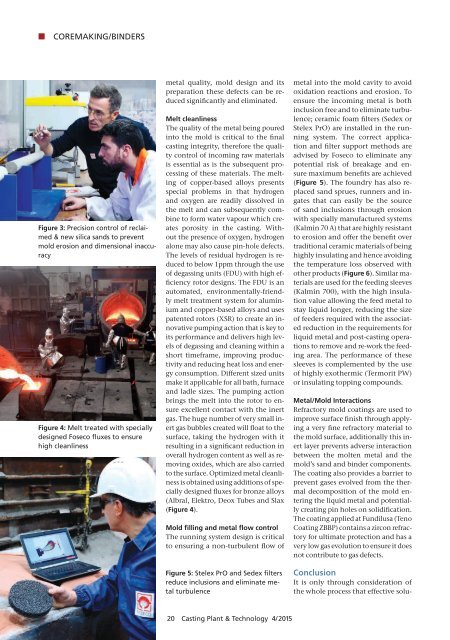CPT International 04/2015
The leading technical journal for the global foundry industry – Das führende Fachmagazin für die weltweite Gießerei-Industrie
The leading technical journal for the
global foundry industry – Das führende Fachmagazin für die
weltweite Gießerei-Industrie
You also want an ePaper? Increase the reach of your titles
YUMPU automatically turns print PDFs into web optimized ePapers that Google loves.
K COREMAKING / BINDERS<br />
Figure 3: Precision control of reclaimed<br />
& new silica sands to prevent<br />
mold erosion and dimensional inaccuracy<br />
Figure 4: Melt treated with specially<br />
designed Foseco fluxes to ensure<br />
high cleanliness<br />
metal quality, mold design and its<br />
preparation these defects can be reduced<br />
significantly and eliminated.<br />
Melt cleanliness<br />
The quality of the metal being poured<br />
into the mold is critical to the final<br />
casting integrity, therefore the quality<br />
control of incoming raw materials<br />
is essential as is the subsequent processing<br />
of these materials. The melting<br />
of copper-based alloys presents<br />
special problems in that hydrogen<br />
and oxygen are readily dissolved in<br />
the melt and can subsequently combine<br />
to form water vapour which creates<br />
porosity in the casting. Without<br />
the presence of oxygen, hydrogen<br />
alone may also cause pin-hole defects.<br />
The levels of residual hydrogen is reduced<br />
to below 1ppm through the use<br />
of degassing units (FDU) with high efficiency<br />
rotor designs. The FDU is an<br />
automated, environmentally-friendly<br />
melt treatment system for aluminium<br />
and copper-based alloys and uses<br />
patented rotors (XSR) to create an innovative<br />
pumping action that is key to<br />
its performance and delivers high levels<br />
of degassing and cleaning within a<br />
short timeframe, improving productivity<br />
and reducing heat loss and energy<br />
consumption. Different sized units<br />
make it applicable for all bath, furnace<br />
and ladle sizes. The pumping action<br />
brings the melt into the rotor to ensure<br />
excellent contact with the inert<br />
gas. The huge number of very small inert<br />
gas bubbles created will float to the<br />
surface, taking the hydrogen with it<br />
resulting in a significant reduction in<br />
overall hydrogen content as well as removing<br />
oxides, which are also carried<br />
to the surface. Optimized metal cleanliness<br />
is obtained using additions of specially<br />
designed fluxes for bronze alloys<br />
(Albral, Elektro, Deox Tubes and Slax<br />
(Figure 4).<br />
Mold filling and metal flow control<br />
The running system design is critical<br />
to ensuring a non-turbulent flow of<br />
Figure 5: Stelex PrO and Sedex filters<br />
reduce inclusions and eliminate metal<br />
turbulence<br />
metal into the mold cavity to avoid<br />
oxidation reactions and erosion. To<br />
ensure the incoming metal is both<br />
inclusion free and to eliminate turbulence;<br />
ceramic foam filters (Sedex or<br />
Stelex PrO) are installed in the running<br />
system. The correct application<br />
and filter support methods are<br />
advised by Foseco to eliminate any<br />
potential risk of breakage and ensure<br />
maximum benefits are achieved<br />
(Figure 5). The foundry has also replaced<br />
sand sprues, runners and ingates<br />
that can easily be the source<br />
of sand inclusions through erosion<br />
with specially manufactured systems<br />
(Kalmin 70 A) that are highly resistant<br />
to erosion and offer the benefit over<br />
traditional ceramic materials of being<br />
highly insulating and hence avoiding<br />
the temperature loss observed with<br />
other products (Figure 6). Similar materials<br />
are used for the feeding sleeves<br />
(Kalmin 700), with the high insulation<br />
value allowing the feed metal to<br />
stay liquid longer, reducing the size<br />
of feeders required with the associated<br />
reduction in the requirements for<br />
liquid metal and post-casting operations<br />
to remove and re-work the feeding<br />
area. The performance of these<br />
sleeves is complemented by the use<br />
of highly exothermic (Termorit PW)<br />
or insulating topping compounds.<br />
Metal/Mold Interactions<br />
Refractory mold coatings are used to<br />
improve surface finish through applying<br />
a very fine refractory material to<br />
the mold surface, additionally this inert<br />
layer prevents adverse interaction<br />
between the molten metal and the<br />
mold’s sand and binder components.<br />
The coating also provides a barrier to<br />
prevent gases evolved from the thermal<br />
decomposition of the mold entering<br />
the liquid metal and potentially<br />
creating pin holes on solidification.<br />
The coating applied at Fundilusa (Teno<br />
Coating ZBBP) contains a zircon refractory<br />
for ultimate protection and has a<br />
very low gas evolution to ensure it does<br />
not contribute to gas defects.<br />
Conclusion<br />
It is only through consideration of<br />
the whole process that effective solu-<br />
20 Casting Plant & Technology 4/<strong>2015</strong>


















